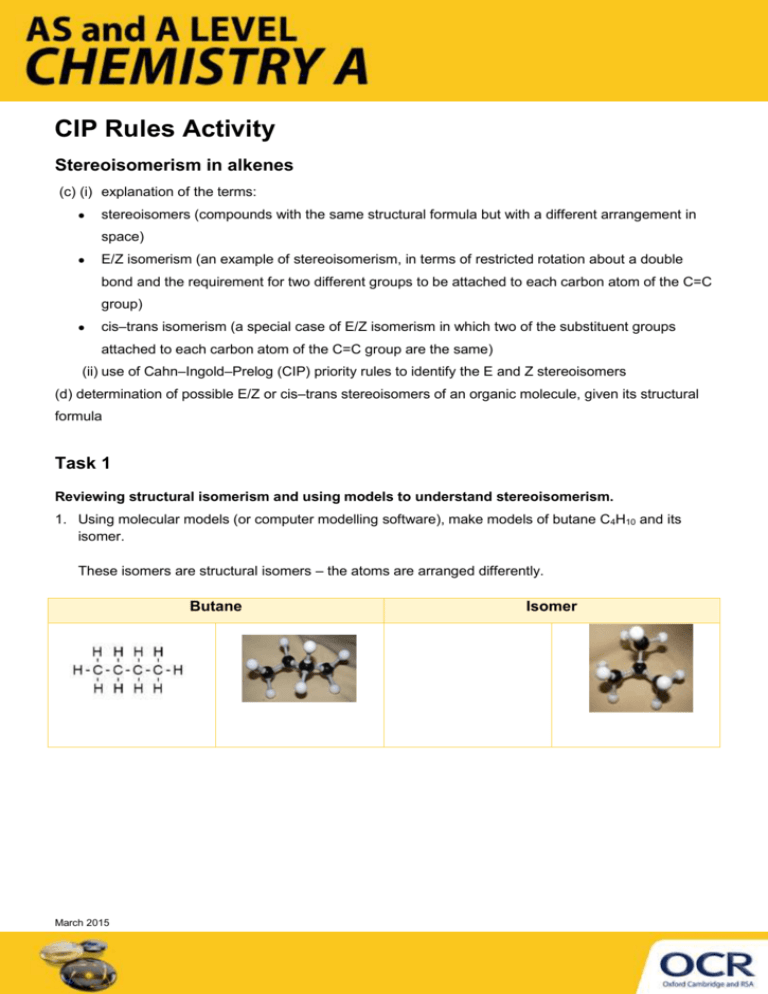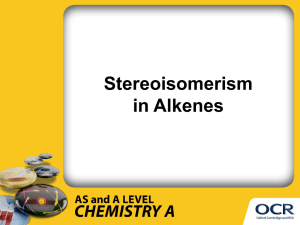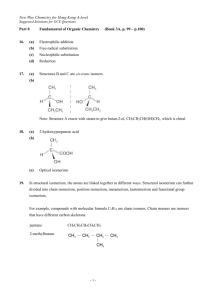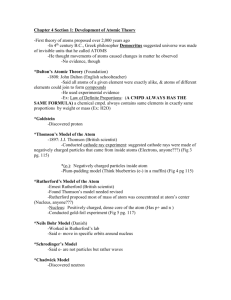CIP rules - Activity
advertisement

CIP Rules Activity Stereoisomerism in alkenes (c) (i) explanation of the terms: stereoisomers (compounds with the same structural formula but with a different arrangement in space) E/Z isomerism (an example of stereoisomerism, in terms of restricted rotation about a double bond and the requirement for two different groups to be attached to each carbon atom of the C=C group) cis–trans isomerism (a special case of E/Z isomerism in which two of the substituent groups attached to each carbon atom of the C=C group are the same) (ii) use of Cahn–Ingold–Prelog (CIP) priority rules to identify the E and Z stereoisomers (d) determination of possible E/Z or cis–trans stereoisomers of an organic molecule, given its structural formula Task 1 Reviewing structural isomerism and using models to understand stereoisomerism. 1. Using molecular models (or computer modelling software), make models of butane C4H10 and its isomer. These isomers are structural isomers – the atoms are arranged differently. Butane March 2015 Isomer 2. Now make models of dichloroethene C2H2Cl2 and its isomers. You should get 3 isomers, the first one is done for you. 1,1 dichloroethene 3. What property does the double bond have that can allow stereoisomerism to happen in 1,2 dichloroethene? Your model should show this. The names are coded. If the methyl groups are on the same side the full name is (Z)1,2 dichloroethene, if the methyl groups are on opposite sides, the name is (E)1,2 dichloroethene. The letters derive from German, Z stands for zusammen (together), while E stands for entgegen (opposite). If two of the groups are the same, we also use the terms cis and trans to describe the two isomers. March 2015 Task 2 Test 1 1. Which of these alkenes shows stereoisomerism? a. H2C=CBr2 b. CH3CH=CHCH3 c. CH3CH=C(CH3)2 d. CHBr=CHBr e. CHCl=CH2 2. What simple rule enables us to decide if an alkene does not show stereoisomerism? March 2015 3. Draw diagrams to show the E and Z isomers of those alkenes that do show stereoisomerism E Z Task 3 Formative Assessment How well did you do? I understand what structural isomers are and can show this by drawing diagrams I understand the difference between structural isomers and stereoisomers I can draw diagrams to show stereoisomers I can name isomers as cis, trans, E or Z March 2015 I can do this I struggled I am lost Task 4 Cahn, Ingold, Prelog (CIP) Rules Not all alkenes are as simple as 1,2 dichloroethene. Make a models of the two stereoisomers of 1bromo 2-chloro 2-iodoethene and draw the structures of them. Deciding on letters for the isomers is harder because there are four different atoms round the double bond. We cannot use the labels cis and trans. Cahn, Ingold and Prelog devised some rules to enable the naming. E/Z descriptors are assigned by using a system for ranking priority of the groups attached to each stereocentre. This procedure, often known as the sequence rules, is the heart of the CIP system. 1. Compare the atomic number (Z) of the atoms directly attached to the stereocentre (double bond); the group having the atom of higher atomic number receives higher priority. 2. If there is a tie, we must consider the atoms at distance 2 from the stereocentre—as a list is made for each group of the atoms bonded to the one directly attached to the stereocentre. Each list is arranged in order of decreasing atomic number. Then the lists are compared atom by atom; at the earliest difference, the group containing the atom of higher atomic number receives higher priority. 3. If there is still a tie, each atom in each of the two lists is replaced with a sub-list of the other atoms bonded to it (at distance 3 from the stereocentre), the sub-lists are arranged in decreasing order of atomic number, and the entire structure is again compared atom by atom. This process is repeated, each time with atoms one bond farther from the stereocentre, until the tie is broken. It is the placing of the two highest priority substituents with respect to the double bond which matters. If both high priority substituents are on the same side of the double bond, i.e. in the cis configuration, then the stereoisomer is assigned a Z or Zusammen configuration. If, by contrast they are in a trans configuration, then the stereoisomer is assigned an E or Entgegen configuration. In summary – the two atoms with greatest atomic mass will be the ones to determine whether the stereoisomer is E or Z. If chains of carbon atoms are involved, the 2 longest chains at opposite ends of the double bond will determine the labelling of the stereoisomer. March 2015 Decide on the order of priority for the 4 atoms round the double bond in1-bromo 2-chloro 2-iodoethene. Priority Atom 1 2 3 4 Now you should be able to name the 2 stereoisomers. Insert the names into the boxes below: March 2015 Task 5 Test 2 Now decide whether the compounds below show stereoisomerism, and draw structures of any E/Z isomers. E 3-chloro-oct-3-ene 3-methylhept-3-ene 2 chloro, 3 ethylhex-2-ene March 2015 Z Task 6 Formative Assessment How well did you do? I can draw diagrams to show the difference between more complex stereoisomers. I can use atomic masses to decide on the priorities of groups I can use the location of the two highest priority groups to assign E and Z labels March 2015 I can do this I struggled I am lost











